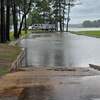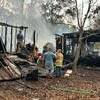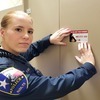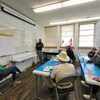Local officials keeping eye on COVID-19
By now, most people have heard of coronavirus -- the newest illness threatening the health of the world.
“The Centers for Disease Control and Prevention (CDC) is closely monitoring the outbreak of respiratory illness caused by the coronavirus disease 2019 (COVID-19),” the CDC’s website states. “Current understanding about how the virus spreads is largely based on what is known about similar coronaviruses, including SARS and MERS.
“For the general American public, who are unlikely to be exposed to this virus at this time, the immediate health risk from COVID-19 is considered low. However, it’s important to note that current global circumstances suggest it is likely that this virus will cause a pandemic. In that case, the risk assessment would be different.”
CDC has developed guidance to help in the risk assessment and management of people with potential exposures to COVID-19.
The outbreak first started in Wuhan, China. The first COVID-19 case in the U.S. was reported on Jan. 21. The first confirmed instance of person-person-spread with this virus in the U.S. was reported on Jan. 30. According to the CDC’s website, as of Tuesday, March 3, a total of 60 cases in 12 states – none in Texas -- in U.S. have been confirmed and six deaths have been reported.
“It’s critical for the public to remember that as we examine potential risks, there is no cause for panic,” U.S. Congressman Lance Gooden (R-TX) said in a statement released Monday, March 2. “I’m focused on making sure Congress does everything we can to prepare for all possible scenarios. I pray no drastic measures are required in order to keep our communities safe and fully functioning, but I'd rather be overprepared than underprepared.”
While CDC officials continue to monitor several people under federal quarantine at JBSA-Lackland in San Antonio, the risk for all Texans remains low, according to officials with the Texas Department of State Health Services (DSHS).
“There are no other cases in Texas, and these cases do not change the risk of infection for people in San Antonio or other parts of Texas,” the DSHS’s website explains, “because the patients have been under federal quarantine since their return and have not interacted with the public in Texas communities.”
State officials met Tuesday, March 3, to discuss the current state of the coronavirus (COVD-19) as well as the state’s emergency response plans. The meeting, hosted by the Office of the Governor, the Texas Division of Emergency Management (TDEM), and the Department of State Health Services (DSHS), was the first in a series of twice-weekly meetings that will address state emergency planning documents and strategies.
The Cherokee County Health Department and local healthcare systems are also taking action to stay on top of the situation.
“The spread of viruses, like the novel coronavirus (COVID-19) or other respiratory illnesses, can occur at any time,” CCHD Public Health Preparedness Branch Manager and Disease Surveillance and SNS Coordinator Grace A. Mikhail said. “Knowing how to react and what steps to take is important in order to protect individuals and communities from getting sick and preventing the spread of viruses.
“While the health risk to the general public in Texas remains low, being prepared and staying informed is important for both individuals, families, and communities.”
Both hospital systems in Cherokee County are also keeping a close eye on the situation and are already taking measures to prepare for the illness, should it reach this area.
“CHRISTUS Health values the importance of collaboration and coordinated action for the identification and care of patients exhibiting signs of COVID-19,” CHRISTUS Health Media/Public Relations Manager William Knous said. “We continue to follow CDC interim guidelines and work non-stop, in partnership with local, state and federal government authorities. We are fortunate to be part of regional health care community committed to responding to the needs of these patients in the safest manner necessary.
“CHRISTUS Health currently convenes daily, sometimes more, to check in on our emergency preparedness plans. We have had many hands on deck during this process. Nearly everyone — from physicians and nurses, quality and safety experts to those responsible for ordering supplies and keeping the hospital clean — is involved in making sure we can do best for our patients, our associates and this community we serve.”
Allison Pollan, director of communications for UT Health East Texas said, “Our clinical teams and infection preventionists are following the recommended protocol set by the CDC. We remain committed to meeting our community’s needs for care while keeping our patients, staff and the community safe. UT Health East Texas regularly prepares for crisis situations to ensure our caregivers are prepared to meet the needs of the communities we serve. Most recently, our hospitals participated in a region-wide effort by RAC-G in October to test emergency preparedness in multiple counties.
“While this event simulated a tornado strike, efforts like these not only help our preparations and response to emergency medical situations, but also strengthen our community partnerships so that we are prepared to work together quickly and efficiently.
“We encourage everyone to practice good hygiene, which helps prevent against the spread of infection. Proper handwashing and wiping down surfaces will help prevent the spread of germs, including flu and other illnesses that are circulating in East Texas this time of year.”
In confirmed COVID-19 cases, reported illnesses have ranged from mild symptoms to severe illness and death. Symptoms can include fever, cough, shortness of breath and can appear in as few as two days or as long as 14 days after exposure.
“There is currently no vaccine to prevent COVID-19 and no medications approved to treat it,” the CDC’s website states. “The best way to prevent illness is to avoid being exposed to this virus.”
Knous added, “It’s still flu season in Texas. We continue to encourage all our patients and the community to practice good respiratory hygiene habits, especially during times like this, where catching the flu is a far greater risk.”
Medical officials recommend these preventative measures for COVID-19 and the flu.
• Avoid close contact with people who are sick.
• Avoid touching your eyes, nose, and mouth.
• Stay home when you are sick.
• Cover your cough or sneeze with a tissue, then throw the tissue in the trash.
• Clean and disinfect frequently touched objects and surfaces using a regular household cleaning spray or wipe.
• Wash your hands often with soap and water for at least 20 seconds, especially after going to the bathroom; before eating; and after blowing your nose, coughing, or sneezing. If soap and water are not readily available, use an alcohol-based hand sanitizer with at least 60 percent alcohol.
• Always wash hands with soap and water if hands are visibly dirty.
The CDC does not recommend people who are well wear a facemask to protect themselves from respiratory diseases, including COVID-19.
“Facemasks should be used by people who show symptoms of COVID-19 to help prevent the spread of the disease to others,” the CDC’s website states.
An ounce of prevention: From the Cherokee County Health Department
The plans you make and the actions you take today matter. The Cherokee County Health Department, Cherokee County Judge Chris Davis, and emergency officials understand that there are several questions and concerns about novel coronavirus (COVID-19).
Updates regarding COVID-19 continue to evolve rapidly, to stay up-to-date or for further information, visit the CDC or DSHS novel coronavirus disease page at: cdc.gov or dshs.texas.gov.
Know the facts.
Fact 1: Someone who has completed quarantine or has been released from isolation does not pose a risk of infection to other people.
Fact 2: Diseases can make anyone sick regardless of their race or ethnicity. People of Asian descent, including Chinese Americans, are not more likely to get COVID-19 than any other American. Help stop fear by letting people know that being of Asian descent does not increase the chance of getting or spreading COVID-19. Viruses cannot target specific populations, ethnicities, or racial backgrounds. Stigma, fear, and anxiety can all lead to an increased sense of panic in individuals and in the community, fighting that stigma starts with YOU.
Fact 3: You can help stop COVID-19 by knowing the signs and symptoms -- fever; cough; and shortness of breath. Seek medical advice if you have traveled to an affected geographic area with widespread or sustained community transmission in the past 14 days and are feeling sick. Call ahead before you go to a doctor’s office or emergency room. Tell them about your recent travel and your symptoms.
Fact 4: There are simple things you can do to help keep yourself and others healthy.
• Wash your hands often with soap and water for at least 20 seconds, especially after going to the bathroom; before eating; and after blowing your nose, coughing, or sneezing. If soap and water are not available, use an alcohol-based hand sanitizer with at least 60 percent alcohol.
Fun fact: Hum the “Happy Birthday” song beginning to end two times -- this can be your 20 second timer.
• Avoid touching your eyes, nose, and mouth with unwashed hands.
• Stay home when you are sick.
• Cover your cough or sneeze with a tissue, then throw the tissue in the trash.
• Clean and disinfect frequently touched objects and surfaces (i.e. toys, handles, desks, doorknobs, and communal gathering spaces) using a regular household cleaning spray or wipe.
Please support The Cherokeean Herald by subscribing today!
